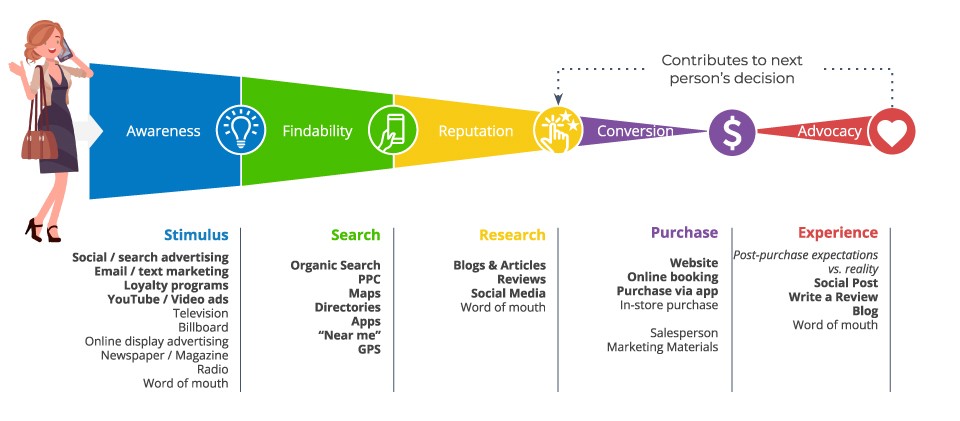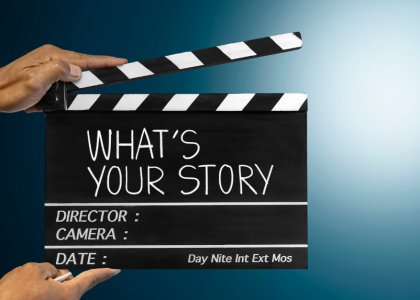The customer journey consists of actions your customers take before and after they make a purchase. It should be part of your overall marketing strategy to improve lead generation and enable more effective marketing. By understanding the different actions your customers take before and after a conversion, you can start brainstorming new marketing tactics to improve the customer experience and keep them coming back for more.
Think of a customer journey as a detailed map that shows the full experience a customer has with your business. It lets you see every interaction they have with your company, even before and after they engage. By first understanding the customer journey, it will be easier to define your goals and use our automation tool to create the overall marketing experience you want to provide.

What is a customer journey?
A customer journey outlines the different steps your customers take to become customers. Without the customer journey, your marketing funnel couldn’t exist. A marketing funnel helps you market your products and services to customers based on where they are in their customer journey. For example, someone researching products is at the top of the marketing funnel or at the very beginning stages of their journey.
Ultimately, a customer journey map tells a story about how customers interact with your brand, including how they first discovered your business to whether or not they’ll make a repeat purchase. The journey lays out different interactions someone could have with your brand, although not every customer needs to use all those touch points before converting.
While not all customer journeys are the same, you can use your website and marketing efforts to easily guide customers through the journey by taking them through different touchpoints.
Request your search audit
- Increase your conversion rate
- Reduce your bounce rate
- Increase your average order value
- Retain your online shoppers
What are the phases of a customer journey for email?
Knowing the customer journey definition is only the beginning; now you must learn the different stages involved. A customer journey is made up of phases, which are the distinct stages a customer passes through as they’re guided to take specific actions. The phases you include will depend on your business goals.
Do you want a user to adopt a new app you’ve released? Are you looking to get inactive newsletter subscribers to read your emails? Is your aim to turn occasional shoppers into regular, loyal customers? All these marketing paths require a strategy for getting your customers from point A to point B.
Most customer journeys will usually account for these phases:
Awareness
This is how someone discovers your company, usually through a search engine or your paid advertising efforts. Let’s say your new future customer sees an ad for your latest line of ‘I Have the World’s Okayest Cat’ mugs, and they click through to your website to learn more about the brand and product. Now your business is stored in their memory.
Acquisition
Congrats! You can now call that new future customer an actual customer, because they loved the ‘I Have the World’s Okayest Cat’ mugs you released so much that they bought one. Not only that, they also signed up for your email list through a form on your site so they can be the first to learn about any new merchandise.
Onboarding
Now that you’ve acquired a new customer, you can send them a series of emails to make them feel welcome, showcase other stuff in your store they might be interested in, and help them understand when and how they might expect to hear from you in the future.
Engagement
This refers to how you can get customers to regularly use your product or service, shop at your store, or read your content. Consider using email, social media, in-product messages, and personalization to make your customers’ experience more enjoyable.
Advocacy
Make your customers so happy that they’ll recommend your brand to others. This is probably one of the best ways to get new customers.
Once you’ve established the phases of a customer journey, you can plan the touchpoints you’ll use to connect with customers at the right moments.
Create Customer Journeys to:
Greet new customers & introduce your brand
First, you need to onboard new people who start following your brand. A great first impression is key to establishing a long-lasting relationship. Begin with an email that thanks people for signing up and provides the information they need to know. Show customers you care about getting to know them by sending a survey to discover what they’re interested in, so you can customize your marketing to fit their needs. You can also use this journey to measure how often your contacts want to hear from you and when they’re most likely to engage.
Reunite shoppers with their carts
Research shows that 69% of e-commerce shoppers abandon their carts before checking out. If you don’t have an abandoned cart automation setup, you’re missing out on a lot of easy sales. Shoppers who have left a cart have already expressed interest in your brand; they just need a nudge back to your store to finish buying. With a journey, not only can you set up an automated email to send when someone abandons a shopping cart, but you can use the flow to highlight other stuff you sell and keep customers coming back.
Re-engage customers who have lost interest
There are several ways you can win back inactive customers—it just depends on what type of engagement is most important for your business goals. You can set up a journey that customers will start when a specific amount of time has passed since they last bought something from your store, or you can target customers who haven’t opened any of your last 5 email campaigns. From there, you can decide what interactions will get these customers to fall in love with your brand again.
Ask for product reviews or feedback on your service
When someone buys a product, that’s the perfect time to reach out and make a connection. Get their thoughts on the order and shipping process. Check in on how they’re liking their purchase. And don’t forget to include a coupon for other stuff in your store they’re sure to love.
Organize your contacts based on their interests and levels of engagement
Use a Customer Journey to help manage your audience based on insights that are important to your business. Make behind-the-scenes changes—like adding and removing tags—that’ll help you send relevant messages and create more meaningful interactions.
Find success with customer journeys
Customer journeys are an important marketing tool to communicate effectively with your customers and lead them down a path to conversion. The easier your customer journey is to follow, and the more touch points you take advantage of, the better experience you can provide. Even after your customers have converted, deliver ongoing support and communication to retain them and promote brand loyalty.
Using eMail to build a customer journey
A Customer Journey is a marketing automation tool that lets you visually map dynamic, automated marketing paths for your customers. Depending on the phases you want customers to pass through—discovery, acquisition, retention, etc.—you can choose the starting points and other unique interactions to engage your customers every step of the way.
Any marketing or purchasing paths that you want to use your data to create can be mapped out with the Customer Journey builder, which allows you to target specific users and focus on what will get them to move from one point to another.
To illustrate this, let’s take a look at the welcome journey that people will enter when they sign up to receive your marketing. You’re probably familiar with welcome emails and have heard us talk about their value a bunch. The concept of a welcome journey is the same: greeting new contacts and introducing them to your brand.
A journey should include emails, but it also differs from an automated welcome email in 2 key ways:
People don’t just trigger an email once they’ve met the criteria of your starting points. They’re added to and start a path that’s customized for them.
- You can plan what actions you want new customers to take throughout this journey and where you want them to end up.
Adding the right mix of rules and actions—including branching points and email—to a journey map can put new subscribers on the path to becoming loyal users and customers. Branching points help make the journeys you build for your customers more dynamic and adaptable, taking customers down If/Else paths based on specific behaviors. - You can also use a Customer Journey to tag new contacts based on insights that are important to your business. This will allow you to track customer interests and send more relevant marketing content later.




